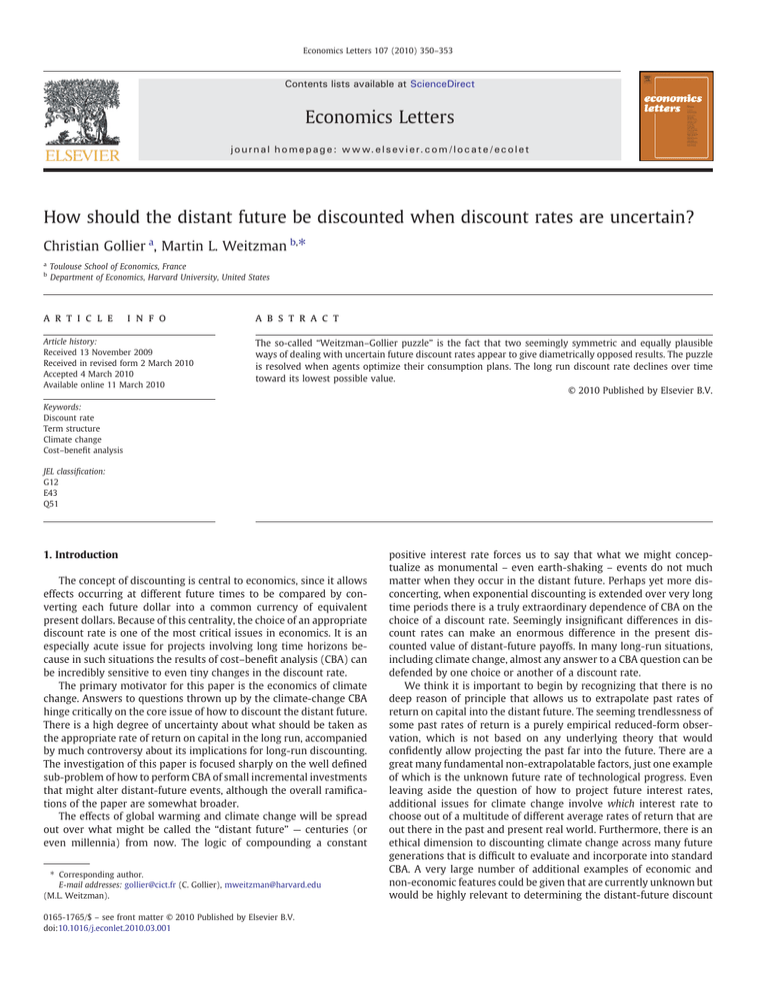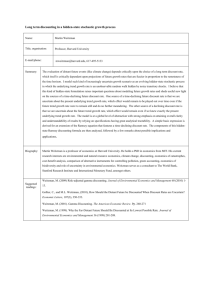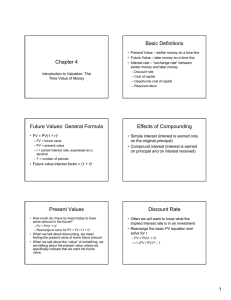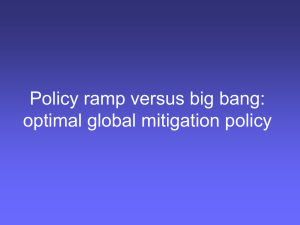How should the distant future be discounted when discount rates... ⁎ Christian Gollier ,
advertisement

Economics Letters 107 (2010) 350–353
Contents lists available at ScienceDirect
Economics Letters
j o u r n a l h o m e p a g e : w w w. e l s ev i e r. c o m / l o c a t e / e c o l e t
How should the distant future be discounted when discount rates are uncertain?
Christian Gollier a, Martin L. Weitzman b,⁎
a
b
Toulouse School of Economics, France
Department of Economics, Harvard University, United States
a r t i c l e
i n f o
Article history:
Received 13 November 2009
Received in revised form 2 March 2010
Accepted 4 March 2010
Available online 11 March 2010
a b s t r a c t
The so-called “Weitzman–Gollier puzzle” is the fact that two seemingly symmetric and equally plausible
ways of dealing with uncertain future discount rates appear to give diametrically opposed results. The puzzle
is resolved when agents optimize their consumption plans. The long run discount rate declines over time
toward its lowest possible value.
© 2010 Published by Elsevier B.V.
Keywords:
Discount rate
Term structure
Climate change
Cost–benefit analysis
JEL classification:
G12
E43
Q51
1. Introduction
The concept of discounting is central to economics, since it allows
effects occurring at different future times to be compared by converting each future dollar into a common currency of equivalent
present dollars. Because of this centrality, the choice of an appropriate
discount rate is one of the most critical issues in economics. It is an
especially acute issue for projects involving long time horizons because in such situations the results of cost–benefit analysis (CBA) can
be incredibly sensitive to even tiny changes in the discount rate.
The primary motivator for this paper is the economics of climate
change. Answers to questions thrown up by the climate-change CBA
hinge critically on the core issue of how to discount the distant future.
There is a high degree of uncertainty about what should be taken as
the appropriate rate of return on capital in the long run, accompanied
by much controversy about its implications for long-run discounting.
The investigation of this paper is focused sharply on the well defined
sub-problem of how to perform CBA of small incremental investments
that might alter distant-future events, although the overall ramifications of the paper are somewhat broader.
The effects of global warming and climate change will be spread
out over what might be called the “distant future” — centuries (or
even millennia) from now. The logic of compounding a constant
⁎ Corresponding author.
E-mail addresses: gollier@cict.fr (C. Gollier), mweitzman@harvard.edu
(M.L. Weitzman).
0165-1765/$ – see front matter © 2010 Published by Elsevier B.V.
doi:10.1016/j.econlet.2010.03.001
positive interest rate forces us to say that what we might conceptualize as monumental – even earth-shaking – events do not much
matter when they occur in the distant future. Perhaps yet more disconcerting, when exponential discounting is extended over very long
time periods there is a truly extraordinary dependence of CBA on the
choice of a discount rate. Seemingly insignificant differences in discount rates can make an enormous difference in the present discounted value of distant-future payoffs. In many long-run situations,
including climate change, almost any answer to a CBA question can be
defended by one choice or another of a discount rate.
We think it is important to begin by recognizing that there is no
deep reason of principle that allows us to extrapolate past rates of
return on capital into the distant future. The seeming trendlessness of
some past rates of return is a purely empirical reduced-form observation, which is not based on any underlying theory that would
confidently allow projecting the past far into the future. There are a
great many fundamental non-extrapolatable factors, just one example
of which is the unknown future rate of technological progress. Even
leaving aside the question of how to project future interest rates,
additional issues for climate change involve which interest rate to
choose out of a multitude of different average rates of return that are
out there in the past and present real world. Furthermore, there is an
ethical dimension to discounting climate change across many future
generations that is difficult to evaluate and incorporate into standard
CBA. A very large number of additional examples of economic and
non-economic features could be given that are currently unknown but
would be highly relevant to determining the distant-future discount
C. Gollier, M.L. Weitzman / Economics Letters 107 (2010) 350–353
rate. The fundamental point is that there is enormous uncertainty and
controversy about choosing an appropriate rate of return for discounting distant-future events, like climate change. Moreover, the
great uncertainty about discounting the distant future is not just an
academic curiosity, but it has critically important implications for
climate-change policy. This disturbing ambiguity has given rise to a
great deal of controversy and a variety of proposed solutions. Our
purpose here is to focus sharply on clarifying this particularly thorny
issue by using a crisp formulation that abstracts away from all other
elements of CBA.
In this paper we construct the simplest possible model for analyzing how to discount the distant future for a CBA decision that must be
made now, when future discount rates are uncertain. We do not
defend this model for its realism and immediate applicability to such
long-term issues as CBA of climate change. Rather, we defend our
abstract optimizing model for its ability to isolate, clarify, and hopefully
bring some closure to a set of controversial issues that have bedeviled
the discounting of distant-future events like climate change.
The bottom-line message we want a reader to take away from this
paper: there exists a rigorous generic argument that the future should
be discounted at a declining rate that approaches asymptotically its
lowest possible value.
2. Background: the “Weitzman–Gollier Puzzle”
In this section we focus on a paradoxical issue, whose proposed
resolution has featured prominently in a number of papers on discounting the distant future. We do not mean to imply that this is the
only important issue in long-term discounting, or that our own resolution of the puzzle is the final word. We are primarily using this
alleged paradox as a way of grabbing a reader's attention in order to
motivate the rigorous analysis that comes with the next section of the
paper.
In the highly stylized model of this paper, time t = 0, 1, 2, ..., is
measured in discrete periods of unit length. To state loosely the issue
at hand, a decision must be taken now, just before time zero (call it
time 0−), whether or not to invest a marginal cost δ that will yield a
marginal benefit ε at future time t. Right now, at time 0−, it is unknown what will be the appropriate future rate of return on capital in
the economy. There are n possible future states of the economy,
indexed by i = 1, 2, ..., n. As of now (time 0−), future state i is viewed
as having marginal product of capital ri with probability pi N 0, where
Σipi = 1. A decision must be made now (at time 0−, just before the
“true” state of the world is revealed at time t = 0) about whether or
not to invest δ now in order to gain payoff ε at future time t. To pose
the problem sharply, it is assumed that immediately after the investment decision is made, at time 0, the true state of the world i is
revealed and the marginal product of capital will thenceforth be ri,
from time t = 0 to time t = ∞. The idea that productivity shocks are
permanent seems an appropriate abstraction for analyzing the
distant-future discount rate. Even if we thought of interest rates as
being a mean-reverting random variable, our best statistical estimate
of this mean is itself a random variable, which makes the reducedform overall stochastic process be non-mean-reverting.
In a pair of articles, Weitzman1 proposed the idea that what should
be probability-averaged at various times is not future discount rates,
but future discount factors. In other words, one should not apply the
average discount rate Σipiri as if it were a time-independent constant.
Instead one should apply the time-dependent average discount factor
A(t) = Σipiexp(−rit), whose corresponding time-dependent “effective” discount rate RW(t) satisfies
n
W
exp −R ðt Þt = ∑ pi expð−ri t Þ;
i=1
1
See Weitzman (1998, 2001).
ð1Þ
351
which can be rewritten as
n
1
W
R ðt Þ = − ln ∑ pi expð−ri t Þ :
t
i=1
ð2Þ
Accepting the above logic, it follows that the investment should be
made (incurring a marginal cost δ now, at time 0−, in order to yield a
marginal benefit ε at future time t) if and only if
exp −RW ðt Þt ≥δ:
ð3Þ
It is not difficult to show that RW(t) defined by Eq. (2) has the
properties
n
W
R ð0Þ = ∑ pi ri ;
i=1
dRW ðt Þ
W
b0; R ð∞Þ = minfri g:
dt
ð4Þ
Unfortunately, Weitzman did not provide a rigorous story to accompany the idea that what should be probability-averaged at various
times is not discount rates, but discount factors. Instead the argument
in his papers was left at the intuitive or heuristic level. A main purpose
of this paper is to provide a rigorous justification for an appropriate
version of Eq. (1)–(4). A simple intuition is derived from observing
that one can anticipate the future benefit ε by reducing productive
capital by the present value ε exp( − rit) at date 0. This reduction will
be fully compensated at date t by the cash flow ε generated by the
project, so that all cash flows are concentrated at date 0. In expectation,
this net present value is positive if and only if condition (3) is satisfied.
In a series of articles, Gollier2 inverted Weitzman's logic to produce a seemingly symmetric discount-rate story with exactly the
opposite properties. Gollier reasoned along the following lines. One
can transfer the initial cost of the project by diverting δ from the
productive capital of the economy at date 0. This is offset by investing δ exp(rit) in the productive capital at date t. This implies that
all cash flows are concentrated at date t. In expectation, this net
future value is positive if
≥δexp RG ðt Þt ;
ð5Þ
where the time-dependent internal rate of return RG(t) satisfies the
condition
G
exp R ðt Þt = ∑pi expðri t Þ:
ð6Þ
This can be rewritten as
G
R ðt Þ =
n
1
ln ∑ pi expðri t Þ :
t
i=1
ð7Þ
It is not difficult to show that RG(t) defined by Eq. (7) has the
properties
G
n
R ð0Þ = ∑ pi ri ;
i=1
G
dR ðt Þ
G
N 0; R ð∞Þ = maxfri g:
dt
ð8Þ
Unfortunately, Gollier did not at first provide a rigorous story to
accompany his idea of using the internal rate of return defined by
Eq. (7). Instead, like Weitzman, his argument was initially presented
at the intuitive or heuristic level.
Aside from sharing the same initial condition RW(0) = RG(0) =
∑piri, the properties of RG(t) and RW(t) are diametrically opposed
(except for the trivial situation in which there is but one sure future
state of the world, in which case the two are criteria are identical).
2
See Gollier (2004, 2009a,b).
352
C. Gollier, M.L. Weitzman / Economics Letters 107 (2010) 350–353
While RW(t) declines over time to the smallest value of {ri}, on the
contrary RG(t) increases over time to the largest value of {ri}.
Both the Weitzman discount rate RW(t) and the Gollier discount
rate RG(t) have a superficial plausibility, but with completely opposite
conclusions and policy implications. If the correct discount rate is one
of (2) or (7), then of necessity the other one must be wrong and will
give the wrong answers to CBA questions. For want of a better name,
this seeming paradox has been dubbed in the literature the “Weitzman–Gollier puzzle,” and it has featured prominently in several
papers about long-term discounting.3 How might a person resolve
this distressing paradox by choosing between two such seemingly
symmetric formulations, with each one having diametrically opposed
implications for distant-future discounting? The answer can only
come from a careful rigorous analysis, which follows in the next section.
3. Resolving the “Weitzman–Gollier Puzzle”
As Gollier pointed out early on, and elucidated more carefully
later, 4 neither the formula for RW(t) given by Eq. (2) nor the formula
for RG(t) given by Eq. (7) are likely correct as they stand when the
evaluation of the safe investment is adjusted for the risk associated
to its financing strategy. Indeed, both formulations contain a germ of
truth that can be turned into a rigorous argument when expressed in
units of marginal utility along an optimal consumption trajectory.
Furthermore, and most importantly, the two rigorous formulations
give the same discount rate (as a function of time), thereby resolving
the “Weitzman–Gollier puzzle.”
While several generalizations are possible, we focus here on the
simplest case, the better to bring across the main points sharply. Our
formal argument proceeds as follows. Break up time into a series of
discrete periods 0, 1, 2, ...t, ... of unit length with corresponding
consumptions C = (C0, C1, ..., Ct, ...). We postulate a very general utility
function, in the spirit of Irving Fisher, of the form V(C). We assume
that V is smoothly differentiable, is strictly concave, has positive first
derivatives, and satisfies some kind of generalized Inada conditions
that will guarantee unique interior solutions. Pure time preference is
already built into this general utility function. A special case of V(C) is
the Ramsey–Koopmans form
∞
V ðCÞ = ∑ expð−ρt ÞU ðCt Þ;
ð9Þ
i. Denote the deterministic optimal consumption trajectory in state i
as C*i = (C*0i, C*1i, ..., C*ti, ...). From the linear production possibilities
frontier (10), reducing consumption at date 0 by one unit in state i
would result in exp(rit) extra units available for increased consumption at time t (without altering the rest of the optimal trajectory).
Such a marginal change in the consumption plan should have no
effect on intertemporal welfare V. Therefore, the optimal deterministic trajectory in state i must satisfy the first-order condition
∂V Ci
∂C0
=
∂V Ci
∂Ct
expðri t Þ
ð11Þ
for all t. This condition, which holds in all states i = 1, ..., n, states that
investors are indifferent about the financing structure of their projects.
Next suppose that an investment opportunity arises at time t = 0−,
just before the “true” state of the world is revealed at time t = 0. This
safe investment opportunity expends marginal cost δ in order to yield
a marginal benefit ε at future time t. Of course the representative
agent wishes that the investment decision could be made with the
precise information available at time t = 0, just after the “true” state of
the world is revealed and the relevant future marginal product of
capital (from time t = 0 to time t = ∞) is known with certainty. But the
essence of the problem of doing CBA with an uncertain future
discount rate is that the investment decision must be made at a time
when it is known only that the uncertain future marginal product of
capital will be ri with probability pi.
By the envelope theorem and given the optimality condition (11),
the possibility to reallocate the costs and benefits of the project over
time has no effect on its impact on V, at the margin. This is the key to
resolve the puzzle, as we demonstrate it below.
The investment project raises the expected utility of the
representative agent if and only if
n
∂V Ci
i=1
∂Ct
∑ pi
n
∂V Ci
i=1
∂C0
≥δ ∑ pi
:
ð12Þ
Using the optimality condition (11), this can be rewritten in two
equivalent ways. The “Weitzman approach” consists in eliminating
∂V(C*i )/∂Ct from the above inequality. It yields
t =0
where ρ N 0, U′(0) = ∞ and U′(∞) = 0. However, in some ways this
special case (9) obscures rather than illuminates the act of seeing
through to the core theoretical structure driving the model's results.
There is just one commodity serving as both consumption and
investment. The notion of capital here is intended to be all-inclusive,
including human capital, knowledge capital, and so forth. The underlying production function of this “generalized capital” is linear. In state
of the world i it is of the form
Kt
+ 1
= expðri Þ½Kt −Ct ;
ð10Þ
where Kt is the capital stock at the beginning of period t. The linearity
of the production possibilities frontier guarantees that the relevant
interest rate in state i will be ri — no matter what is the form of the
general Fisherian utility function V.
It is critical in this model to understand the exact timing sequence
concerning what information is available at what time, and when
decisions are made. The base-case scenario is this. At time 0, the
inherited capital stock is given as K0 and the state of the world is
known. It is assumed that the deterministic problem of maximizing
V(C) subject to Eq. (10) has a unique interior bounded solution for all
3
4
See, e.g., Buchholz and Schumacher (2008) and Freeman (2009).
See Gollier (2009a,b).
n
W
pi
W
ε ∑ qi expð−ri t Þ≥δ with qi ≡
i=1
∂V Ci
∂C0
∂V Ci
n
∑i = 1 pi
∂C
:
ð13Þ
0
(t)
This is equivalent to discount the future flow ε at a rate RW
⁎
defined as follows:
n
1
W
W
R ðt Þ = − ln ∑ qi expð−ri t Þ :
t
i=1
ð14Þ
Alternatively, the “Gollier approach” consists in eliminating ∂ V(C*i )/
∂ C0 from Eq. (12) by using condition (11). It yields
n
G
G
ε≥δ ∑ qi ðt Þexpðri t Þ with qi ðt Þ≡
i=1
pi
∂V Ci
∂Ct
∂V Ci
n
∑i = 1 pi
∂C
:
ð15Þ
t
This is equivalent to discount the future flow ε at a rate RG⁎ (t)
equaling
n
1
G
G
Rðt Þ = ln ∑ qi ðt Þexpðri t Þ :
t
i=1
ð16Þ
C. Gollier, M.L. Weitzman / Economics Letters 107 (2010) 350–353
Observe the close links between the definition of (RW
(t), RG⁎ (t)) in
⁎
Eqs. (14) and (16) and the definition of (RW(t), RG(t)) in Eqs. (2) and
(7). They are equal up to a risk adjustment of probabilities. Weitzman
converts all cash flows into consumption at time 0 and adjusts statecontingent net present values with units of marginal utility at time 0.
Gollier converts all cash flows into consumption at time t and adjusts
net future values with units of marginal utility at time t. These risk
adjustments are crucial because, although the properties of RW(t) and
RG(t) are very heterogeneous, it is very easy to check from the optimality condition (11) that
W
G
R ðt Þ = R ðt Þ
for all ts! This means that the adjustment of the valuation for risk
resolves the “Weitzman–Gollier puzzle”. Let R⁎(t) denote this
efficiently risk-adjusted discount rate.
It remains to explore the properties of this common risk-adjusted
discount rate. Using the easier formulation R⁎ = RW
, it is not difficult to
⁎
show that
W
R ð0Þ = ∑qi ri ;
dR ðt Þ
b0; R ð∞Þ = minfri g;
dt
ð17Þ
so that qualitatively the properties of the efficient discount rate R⁎(t)
resemble closely those of RW(t) recommended by Weitzman, with the
only quantitative difference being the substitution of “Weitzmanadjusted probabilities” {qW
i } for the unadjusted probabilities {pi}. It is
good to provide an intuition to the result that the term structure of the
socially efficient discount rate be decreasing. In this model in which
shocks on capital productivity are permanent, risk on consumption
growth are also permanent, as seen from Eq. (11). This implies that
risks are magnified by time, compared to the more standard Brownian
motion in which it is known that the term structure of discount rate is
flat. What are the consequences of this magnification of long-term risk
on the discount rate for long maturities? Intuitively, future risk should
induce prudent consumers to sacrifice more for this future. This is the
Keynesian notion of precautionary saving. This is translated into using
a smaller discount rate.
Let us illustrate this result by considering the special case of the
Ramsey–Koopmans specification (Eq. (9)) for V. Let us in particular
consider the case of the logarithmic utility function U(C) = lnC.
In that case, one can rewrite the optimality condition (11) as
Cit = Ci0exp(ri − ρ)t. Rewriting the intertemporal budget constraint
(Eq. (10)) as K0 = ΣtCitexp(−rit) and eliminating Cit yields that
Ci0 = K0 ð1−expð−ρÞÞ
for all i = 1, ..., n. Observe that the initial consumption is risk free in
this special case. As is well-known, consumption is not affected by a
change in the interest rate in the logarithmic case. It implies that one
353
is neutral to the small risk affecting the net present value of the
project at date 0, which implies in turn that the Weitzman rule RW(t)
given in Eq. (2) is correct in that case. This can be seen by observing in
W
W
Eq. (13) that qW
i = pi for all i, so that R⁎ (t) = R⁎(t) = R (t)!. In this
case, the Weitzman's rule was qualitatively and quantitatively correct.
4. Concluding remarks
We will not bother to go through all of the many caveats that
should attach to the results of this paper. Nor shall we discuss possible
extensions to more complicated and realistic situations.
The bottom-line message that we wish for readers to take away
from this paper is the following. When future discount rates are
uncertain but have a permanent component, then the “effective”
discount rate must decline over time toward its lowest possible value.
Empirically, this important feature can have significant ramifications
for climate-change CBA — by weighting the distant future much more
heavily than is done by standard exponential discounting at a
constant rate.5
Acknowledgments
We are grateful to Ben Groom and Christian Traeger for helpful
comments. The research leading to these results has received funding
from the Chair “Sustainable Finance and Responsible Investment” at
TSE, and from the European Research Council under the European
Community's Seventh Framework Programme (FP7/2007–2013)
Grant Agreement no. 230589.
References
Buchholz, W., Schumacher, J., 2008. Discounting the long distant future: a simple
explanation for the Weitzman–Gollier puzzle. Working paper: University of
Regensburg.
Freeman, M.C., 2009. Yes, we should discount the far-distant future at its lowest
possible rate: a resolution of the Weitzman–Gollier Puzzle. Economics E-journal
Discussion Paper 2009-42.
Gollier, C., 2004. Maximizing the expected net future value as an alternative strategy to
gamma discounting. Finance Research Letters 1 (2), 85–89.
Gollier, C., 2009a. Should we discount the far-distant future at its lowest possible rate?
Economics: the Open-Access, Open-Assessment E-Journal, vol. 3: 2009-25.
Gollier, C., 2009b. Expected net present value, expected net future value, and the
Ramsey rule. CESifo working paper #2643.
Groom, B., Koundouri, P., Panopoulou, E., Pantelidis, T., 2007. Discounting the distant
future: how much does model selection affect the certainty equivalent rate?
Journal of Applied Econometrics 22 (3), 641–656.
Newell, R., Pizer, W.A., 2003. Discounting the distant future: how much do uncertain
rates increase valuations? Journal of Environmental Economics and Management
46 (1), 52–71.
Weitzman, M.L., 1998. Why the far-distant future should be discounted at its lowest
possible rate. Journal of Environmental Economics and Management 36 (3),
201–208.
Weitzman, MartinL., 2001. Gamma discounting. American Economic Review 91 (1),
260–271 March.
5
See, e.g., Newell and Pizer (2003), or Groom et al. (2007).





